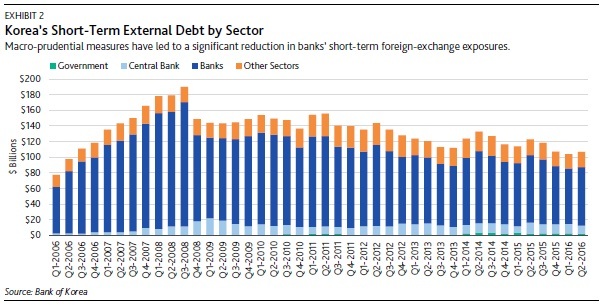Last Tuesday, the Bank of Korea reported that the country’s net international investment position at the end of June had reached $234.1 billion, or 17% of 2015 GDP, a $103.7 billion increase from a year earlier and the highest level since the country began recording the statistic in 1994.
This is credit positive for Korea (Aa2 stable) because it reflects a continued and significant strengthening of the country’s external payments position, which reduces the sovereign’s vulnerability to global financial market shocks and capital outflows.
The continued strengthening in Korea’s international investment position since 2011 reflects large and sustained current account surpluses, which we estimate at 6.9% of GDP in 2016. These surpluses shield the government, banking and corporate sectors from capital outflows, particularly during periods of heightened global financial market uncertainty and geopolitical risk that threaten to disrupt capital flows.
Strengthened external buffers and reduced susceptibility to capital outflows provide the authorities with more monetary policy flexibility to offset potential negative shocks.
However, the large current account surpluses and rapid increase in the international investment position also reflect weak consumption and subdued investment. This is reflected in the country’s more moderate GDP growth, which averaged 3.0% over the past five years, versus 5.7% in the decade preceding the global financial crisis.
Nevertheless, Korea is now better insulated from the types of external funding market shocks that it experienced in 2008 and even more in 1997, when the country asked for support from the International Monetary Fund.
A fundamental development underlying the strengthening of Korea’s international investment position since the global financial crisis and a sudden stop in cross-border dollar credit following the September 2008 Lehman Brothers bankruptcy has been a reduction in Korean banks’ offshore borrowing.
Before the Lehman crisis, Korea’s external balance sheet had deteriorated sharply. The increasing net liability balance of Korea’s international investment position during 2004-07 was largely driven by a run-up in external debt (see Exhibit 1).

As panic erupted during the global financial crisis, heightened risk aversion and a lack of dollar liquidity among Korean banks had particularly disruptive effects on the stability of Korea’s financial system and economy. The Bank of Korea was forced to tap into the US Federal Reserve’s $30 billion swap line in late 2008, which bolstered investor confidence and effectively halted the near sudden stop in funding to Korea’s heavily wholesale-funded banks.
The Bank of Korea’s implementation of macro-prudential measures since then, as well as improved risk management by Korean banks, are the reasons for the significant improvement in Korean banks’ funding and the containment of systemic risks.
Korean banks reduced their total external debt to $174.8 billion in June 2016 from $220.8 billion in September 2008. Short-term external bank debt has declined by a larger margin to $74.8 billion in June 2016 from $159.3 billion in September 2008 (see Exhibit 2).

In light of an easing in potentially destabilizing capital inflow pressures, the government in June announced revisions to its macro-prudential regulations, including raising the leverage cap on foreign-exchange forward positions to 40% of bank capital from 30% for local banks, and to 200% from 150% for foreign bank branches in Korea.
Although this risks increasing short-term foreign-exchange borrowings, it will grant banks more flexibility in securing their foreign exchange liquidity needs, allowing them to better respond to potential future capital outflows.
Source: Moody‘s Investors Service









![[Today’s K-pop] Blackpink’s Jennie, Lisa invited to Coachella as solo acts](http://res.heraldm.com/phpwas/restmb_idxmake.php?idx=644&simg=/content/image/2024/11/21/20241121050099_0.jpg)